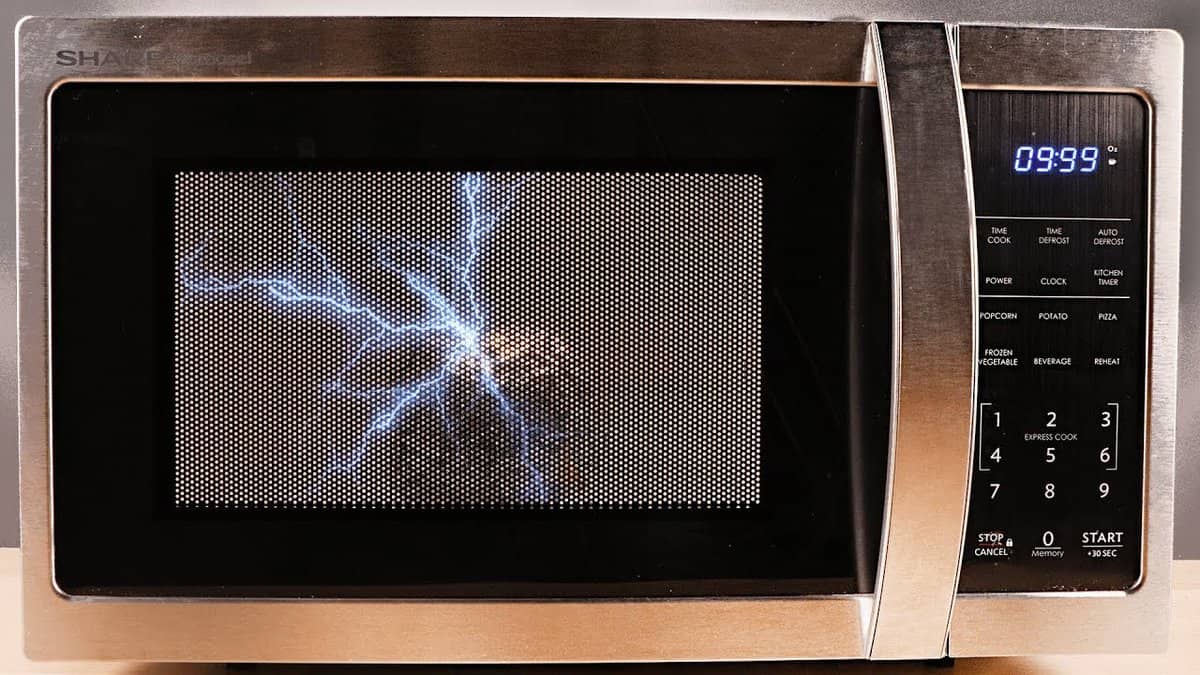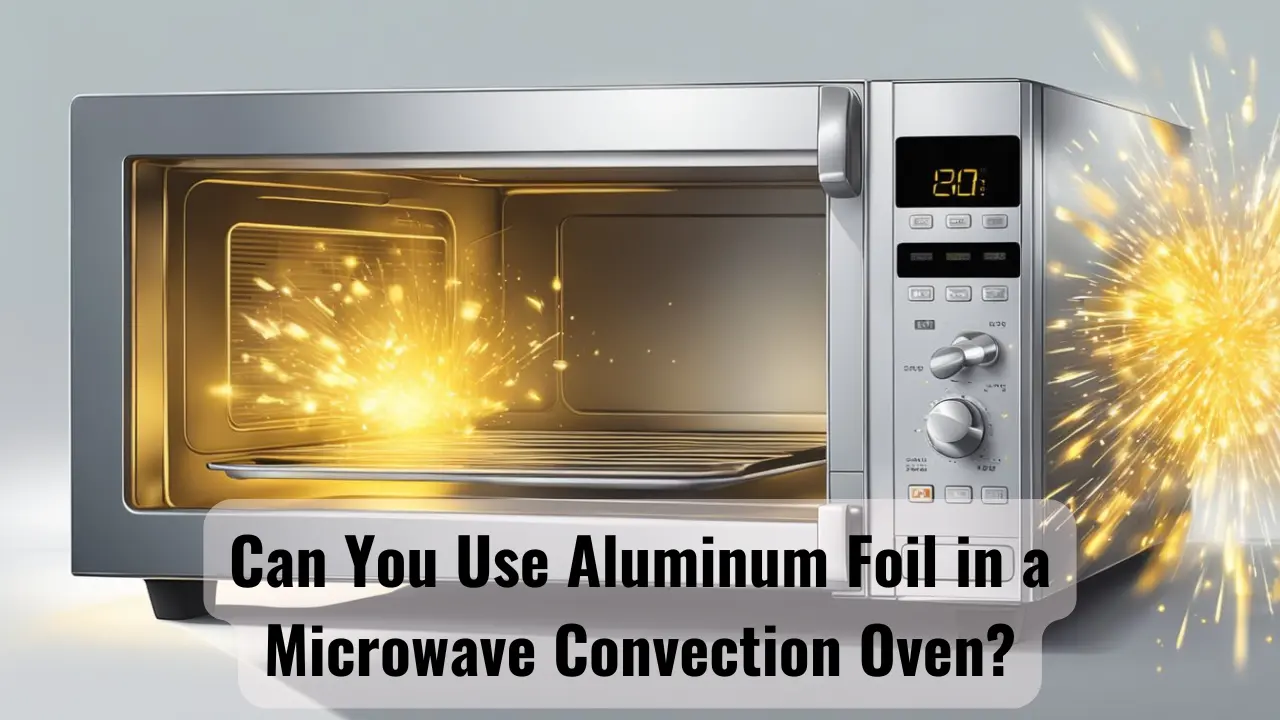Yes, you can use aluminum foil in a microwave convection oven, but only when the appliance is set to convection mode.
In this mode, the oven functions like a traditional oven, and metals like aluminum foil or small baking sheets are safe to use.
However, never use metal in microwave mode, as it can cause sparks and potentially start a fire. Always refer to your appliance’s user manual for specific guidelines on using aluminum foil safely.

Credit: megafurniture.sg
Introduction To Microwave Convection Ovens
Microwave convection ovens allow the use of aluminum foil under certain conditions. Ensure the foil does not touch the oven walls to prevent sparks. This can help with even cooking and browning.
Microwave convection ovens are versatile and efficient kitchen appliances. They combine the speed of a microwave with the even cooking of a convection oven. This makes them a great choice for busy households. But what exactly are they, and how do they work?
What Is A Microwave Convection Oven?
A microwave convection oven is a two-in-one appliance. It uses both microwave and convection cooking methods. This means it can cook food quickly and evenly. It is different from a regular microwave. A regular microwave only uses microwave radiation to heat food.
How Does It Work?
A microwave convection oven works in two ways. First, it uses microwave radiation to heat food from the inside. Second, it uses a fan to circulate hot air around the food. This helps to cook the food evenly and quickly. The combination of these methods makes it a powerful kitchen tool.
“`
Properties Of Aluminum Foil
Aluminum foil can be used in microwave convection ovens with caution. Avoid letting it touch the oven walls or floor. Ensure it covers food properly to prevent arcing.
Aluminum foil stands out for its unique properties. It is lightweight yet strong. This makes it versatile in many applications. Let’s dive into its key properties.
Composition Of Aluminum Foil
Aluminum foil is made from an aluminum alloy. The alloy contains 92-99% aluminum. Manufacturers roll it into thin sheets. The thickness ranges from 0.00017 to 0.0059 inches. It can be very thin but still durable.
Common Uses In Cooking
In cooking, aluminum foil is a staple. It is used for wrapping food. This helps to keep it fresh. It is also used for lining baking sheets. This prevents sticking and makes cleanup easier. Another use is covering dishes in the oven. This prevents the top from burning while the food cooks thoroughly.
“`
Safety Concerns With Aluminum Foil
Using aluminum foil in a microwave convection oven raises safety concerns. It’s crucial to understand these concerns before you proceed. The combination of microwaves and aluminum foil can lead to dangerous situations.
Potential Hazards
Aluminum foil can cause sparks in a microwave. These sparks can ignite fires. Thin aluminum foil pieces can even melt. This could damage the microwave. The intense heat can also affect the food inside the oven.
Microwaves react with metals. This reaction creates electrical currents. These currents can cause arcing. Arcing is a type of electrical discharge. It can be hazardous and lead to fires.
Previous Incidents
Many people have faced issues using aluminum foil. Reports include sparks and small fires. Some users experienced damaged microwave interiors. In some cases, food was left unevenly heated or burned.
These incidents highlight the risks. They show how important it is to handle aluminum foil correctly. Always read your microwave’s manual. Follow guidelines to ensure safety.

Credit: megafurniture.sg
Using Aluminum Foil In Microwave Convection Ovens
Have you ever wondered if you can use aluminum foil in your microwave convection oven? Well, you’re not alone! Many people ask this question. It’s a common concern, especially for those who love cooking and want to ensure they are using their appliances safely. Let’s dive into the details and unravel the mystery.
Manufacturer Guidelines
The first step in determining if you can use aluminum foil in your microwave convection oven is to check the manufacturer’s guidelines. Each appliance is different, and manufacturers provide specific instructions on what is safe to use in their ovens. Here are a few ways to find this information:
- Read the user manual that came with your microwave convection oven.
- Visit the manufacturer’s website for detailed instructions.
- Look for a sticker or label on the appliance itself.
Following these guidelines is crucial to avoid any potential damage to your oven or, worse, causing a fire hazard. When in doubt, always err on the side of caution.
Safe Practices
Now, if your manufacturer has given the green light to use aluminum foil, it’s important to follow some safe practices to ensure everything goes smoothly. Here are some tips:
- Use small pieces: Only use small pieces of aluminum foil to cover food. Large pieces can reflect microwave energy, causing sparks and potentially damaging your oven.
- Avoid covering entire dishes: Never cover an entire dish with foil. This can block the heat and prevent your food from cooking evenly.
- Keep it smooth: Ensure the foil is smooth and not crumpled. Wrinkled foil can create electrical arcs, which are dangerous.
- Keep distance: Make sure the foil is not too close to the oven walls. Keeping a distance prevents any chance of sparks.
In addition to these tips, always monitor your food while it’s cooking. If you notice any sparks or hear popping sounds, stop the microwave immediately and check the foil. Safety first!
Remember, while aluminum foil can be a handy tool in your kitchen, it must be used correctly. Understanding and adhering to manufacturer guidelines and safe practices will keep your microwave convection oven in good working order and your cooking adventures safe and successful.
Alternatives To Aluminum Foil
Aluminum foil is not always safe for use in microwave convection ovens. There are several alternatives that ensure safety and efficiency. These alternatives can also enhance your cooking experience.
Microwave-safe Containers
Microwave-safe containers are a great alternative. They are designed to withstand high temperatures. These containers come in various materials like glass, ceramic, and certain plastics. Glass and ceramic containers do not react with food. This makes them an excellent choice for healthy cooking.
Make sure the container is labeled microwave-safe. This ensures it will not melt or release harmful chemicals. These containers are also reusable, reducing waste. They are easy to clean and maintain, making them a convenient option for daily use.
Silicone Baking Mats
Silicone baking mats are another excellent alternative. They are non-stick, reusable, and can withstand high temperatures. These mats are perfect for baking, roasting, and reheating food. They are flexible and can be cut to fit any size of the baking tray.
Silicone mats distribute heat evenly. This ensures your food cooks perfectly every time. They are also easy to clean. Simply rinse with warm water and soap. These mats are a cost-effective and eco-friendly option. They eliminate the need for aluminum foil and parchment paper.

Credit: www.gibbonsfuneralhome.com
Benefits Of Using Aluminum Foil
Using aluminum foil in a microwave convection oven offers several benefits. It can enhance your cooking experience and make your food taste better. Let’s explore some of the key advantages.
Even Cooking
Aluminum foil helps distribute heat evenly. This prevents hot spots and ensures your food cooks uniformly. For instance, when baking cookies, foil can help them brown evenly.
Covering dishes with foil also helps maintain consistency. It keeps the edges from burning while the center cooks thoroughly. This is especially useful for complex dishes that require precise cooking.
Heat Retention
Aluminum foil retains heat well. This is beneficial for foods that need to stay warm for longer periods. It keeps your food hot, even after turning off the oven.
Foil also helps keep moisture in. This prevents your food from drying out. Your dishes stay juicy and flavorful. It’s perfect for roasts and baked goods.
Myths And Facts
Using aluminum foil in a microwave convection oven can be a confusing topic. Some people think it is dangerous, while others believe it is perfectly safe. Here, we will clear up the myths and provide the facts so you can use your oven without worry.
Common Misconceptions
There are many misconceptions about using aluminum foil in microwave convection ovens. Here are some of the most common ones:
- Aluminum foil always causes sparks: This is not entirely true. While it can cause sparks if used incorrectly, it is safe if used properly.
- It will damage your oven: If you use foil the right way, it will not harm your microwave convection oven.
- Food will not cook properly: Actually, aluminum foil can help cook food evenly and prevent it from burning.
Scientific Evidence
Let’s look at some scientific facts to understand why these misconceptions exist:
| Myth | Fact |
|---|---|
| Aluminum foil always sparks in the microwave. | Foil only sparks if it is crumpled or if it touches the oven walls. |
| Using foil will damage the microwave. | Proper use of foil, without crumpling or direct contact with oven walls, is safe. |
| Food wrapped in foil will not cook evenly. | Foil can help to cook food evenly by reflecting heat. |
Scientific studies show that when aluminum foil is used correctly, it does not pose a risk. For instance, many recipes recommend covering food with foil to prevent it from drying out.
As a personal anecdote, I once wrapped a chicken breast in foil before placing it in my microwave convection oven. The chicken was juicy and perfectly cooked, without any sparks or damage to the oven. So, next time you are unsure about using foil, remember these facts and use it wisely.
In conclusion, using aluminum foil in a microwave convection oven is not as dangerous as it seems. Follow the guidelines, and you can cook delicious meals without any problems. Happy cooking!
Frequently Asked Questions
Can I Put Aluminum Foil In A Microwave Convection Oven?
No, you should not put aluminum foil in a microwave convection oven. It can cause sparks and fire hazards.
Why Can’t You Use Aluminum Foil In A Convection Oven?
Aluminum foil can block airflow in a convection oven. This leads to uneven cooking and potential damage. It’s best to use oven-safe cookware designed for convection ovens.
What Material Can Be Used In A Convection Microwave?
Use microwave-safe glass, ceramic, and heat-resistant plastic. Avoid metal and aluminum foil. Check manufacturer guidelines for safety.
Why Aluminium Foil Cannot Be Used In Microwave?
Aluminium foil reflects microwaves, causing sparks and fire hazards. It can damage the microwave and create safety risks.
Conclusion
Using aluminum foil in a microwave convection oven requires careful attention. Follow guidelines to avoid damage. Always consult your oven’s manual. Small foil pieces can be safe. Avoid large sheets of foil. Ensure proper ventilation to prevent sparks. Test with small amounts first.
Practice caution. Your oven and food will thank you. Safe cooking leads to tasty meals.

